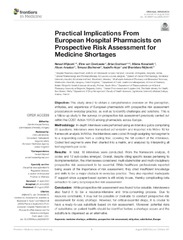Приказ основних података о документу
Practical Implications From European Hospital Pharmacists on Prospective Risk Assessment for Medicine Shortages
| dc.creator | Miljković, Nenad | |
| dc.creator | van Overbeeke, Eline | |
| dc.creator | Godman, Brian | |
| dc.creator | Kovačević, Milena | |
| dc.creator | Anastasi, Alison | |
| dc.creator | Bochenek, Tomasz | |
| dc.creator | Huys, Isabelle | |
| dc.creator | Miljković, Branislava | |
| dc.date.issued | 2020 | |
| dc.identifier.issn | 2296-858X | |
| dc.identifier.uri | https://farfar.pharmacy.bg.ac.rs/handle/123456789/3732 | |
| dc.description.abstract | Objective: This study aimed to obtain a comprehensive overview on the perception, attitudes, and experience of European pharmacists with prospective risk assessment procedures in everyday practice, as well as to identify challenges and solutions. This is a follow-up study to the surveys on prospective risk assessment previously carried out within the COST Action 15105 among pharmacists across Europe. Methodology: In-depth interviews were performed using an interview guide comprising 25 questions. Interviews were transcribed ad verbatim and imported into NVivo 10 for framework analysis. In NVivo, the interviews were coded through assigning text segments to a responding code from a coding tree, covering the full content of the interviews. Coded text segments were then charted into a matrix, and analyzed by interpreting all text segments per code. Results: In total, 18 interviews were conducted. From the framework analysis, 6 codes and 12 sub-codes emerged. Overall, despite citing specific issues pertaining to its implementation, the interviewees considered multi-stakeholder and multi-disciplinary prospective risk assessment to be essential. While healthcare professionals reported being aware of the importance of risk assessment, they cited insufficient knowledge and skills to be a major obstacle in everyday practice. They also reported inadequate IT support since a paper-based system is still widely in use, thereby complicating data extraction to carry out prospective risk assessment. Conclusion: While prospective risk assessment was found to be valuable, interviewees also found it to be a resource-intensive and time-consuming process. Due to resource constraints, it may not be possible or desirable to conduct prospective risk assessment for every shortage. However, for critical-essential drugs, it is crucial to have a ready-to-use substitute based on risk assessment. Moreover, potential risks of substitutes on patient health should be identified before a shortage occurs and the substitute is dispensed as an alternative. | en |
| dc.language.iso | en | sr |
| dc.publisher | Frontiers Media S.A. | |
| dc.relation | COST Action CA 15105 | sr |
| dc.rights | openAccess | sr |
| dc.rights.uri | https://creativecommons.org/licenses/by/4.0/ | |
| dc.source | Frontiers in Medicine | sr |
| dc.subject | medicine shortage | sr |
| dc.subject | antibiotics | sr |
| dc.subject | prospective risk assessment | sr |
| dc.subject | mitigation | sr |
| dc.subject | substitution | sr |
| dc.subject | Europe | sr |
| dc.title | Practical Implications From European Hospital Pharmacists on Prospective Risk Assessment for Medicine Shortages | en |
| dc.type | article | sr |
| dc.rights.license | BY | sr |
| dcterms.abstract | Миљковић, Бранислава; Хуyс, Исабелле; Боцхенек, Томасз; Aнастаси, Aлисон; Ковачевић, Милена; Годман, Бриан; ван Овербееке, Елине; Миљковић, Ненад; Працтицал Имплицатионс Фром Еуропеан Хоспитал Пхармацистс он Проспецтиве Риск Aссессмент фор Медицине Схортагес; Працтицал Имплицатионс Фром Еуропеан Хоспитал Пхармацистс он Проспецтиве Риск Aссессмент фор Медицине Схортагес; | |
| dc.citation.volume | 7 | |
| dc.citation.epage | 1-12 | |
| dc.citation.rank | M21 | |
| dc.identifier.wos | 000563329400001 | |
| dc.identifier.doi | 10.3389/fmed.2020.00407 | |
| dc.identifier.scopus | 2-s2.0-85089800232 | |
| dc.identifier.fulltext | https://farfar.pharmacy.bg.ac.rs/bitstream/id/8428/Practical_Implications_From_pub_2020.pdf | |
| dc.type.version | publishedVersion | sr |

